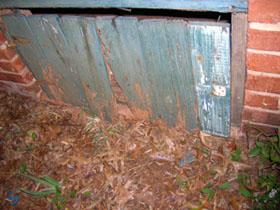Camel crickets get their name because of their slightly humpbacked appearance (Figure 1). Their long legs give them a spider-like appearance. Unlike other crickets, they do not have wings as adults. There are actually several species called camel crickets, but most of them are unimportant as pests. One species, Tachycines asynamorous or "greenhouse stone cricket" frequently becomes a nuisance indoors. As its name suggests, this species is frequently found in greenhouses. Unlike most cricket species that we see, camel crickets do not "chirp". If you are hearing chirping sounds indoors, then you likely have field crickets, which can be controlled in the same manner, as outlined below. Outdoors, camel crickets are typically found in moist areas including under stones and logs, or in stacks of firewood. Areas that are overgrown with vegetation such as ivy and other ground covers provide excellent hiding places (harborages). Camel crickets pass the winter as nymphs (immatures) or adults. The nymphs looks almost identical to the adult, except that they are smaller. In early spring, adult females begin to lay eggs in the soil. A few weeks later, the nymphs hatch from these eggs.
Problems with Camel Crickets
Camel crickets often become a problem when we have extremes in weather conditions, i.e, excessive rainfall or extended periods of hot, dry weather. Like many insect pests, camel crickets are attracted to cool, moist / humid areas in and around our homes. The crickets often invade storage buildings, crawlspaces, basements, garages and indoor areas where moisture may be a problem (e.g., bathrooms, laundry rooms, etc.). A telltale sign of a heavy infestation is the presence of dark fecal smears on surfaces (such as on the floor joist in Figure 2). Although they are mostly a nuisance pest, they can damage stored items, such as garments and linens packed in boxes in a garage or basement if the problem goes unchecked for some time and the crickets cannot find suitable food.
Non-Chemical Control Methods
Although pesticides can help reduce the nuisance problems with camel crickets, they are not a long-term solution. Effective control starts with eliminating harborage sites, reducing conditions that are conducive or attractive to these pests and by excluding these insects from our homes:
- Caulk or seal gaps and openings around windows frames, doors, foundation and clothes dryer vents, crawlspace access doors (Figure 3), soffits, as well as where heating / AC and plumbing lines pass through the foundation.
- Install weather-stripping along the bottom of house and garage doors so that it fits tightly against the threshold.
- Stack boxes and other items off of the ground and away from the walls in a garage or storage building. This helps improve airflow and makes it easier to check for crickets and other pests, including termites.
- Reduce moisture indoors, as well as in other critical areas such as basements or crawlspaces.
- Keep ground cover and mulch at least 12 inches or more away from the foundation. When possible, use an inorganic cover such as gravel up near the foundation.
- Keep ground cover and shrubs away from the foundation and siding. Do not stack firewood against the house. Remove piles of lumber or other clutter under decks that might attract crickets and other pests.
- Place sticky boards, such as those used for cockroaches and mice, in corners and behind appliances to catch crickets that enter your home.
Chemical Control
Outdoors
Any chemical control should focus first on outdoor barrier treatments. Sprays applied to foundation walls, around vents crawlspace accesses, basement doors and windows, and insecticidal baits applied along the perimeter can be quite effective unless there are heavy rains. In crawlspaces, insecticidal baits placed in corners or along the sill plate will be most effective. Spraying in a confined area, such as a crawlspace, requires caution and the proper application and safety equipment. Granular baits are a better choice for use in a crawlspace, but these products are not readily available to the general pubilc. You can or else contact a licensed pest control company for assistance. Consult your local N.C. Cooperative Extension Center or the North Carolina Agricultural Chemicals Manual for a list of appropriate pesticides.
Indoors
Any of the common household (indoor) insecticides can be applied to baseboards, and areas behind appliances. However, if you follow the steps outlined earlier for excluding these pests, the need for indoor applications should be reduced.
Publication date: June 1, 2018
Reviewed/Revised: June 14, 2023
Recommendations for the use of agricultural chemicals are included in this publication as a convenience to the reader. The use of brand names and any mention or listing of commercial products or services in this publication does not imply endorsement by NC State University or N.C. A&T State University nor discrimination against similar products or services not mentioned. Individuals who use agricultural chemicals are responsible for ensuring that the intended use complies with current regulations and conforms to the product label. Be sure to obtain current information about usage regulations and examine a current product label before applying any chemical. For assistance, contact your local N.C. Cooperative Extension county center.
N.C. Cooperative Extension prohibits discrimination and harassment regardless of age, color, disability, family and marital status, gender identity, national origin, political beliefs, race, religion, sex (including pregnancy), sexual orientation and veteran status.



